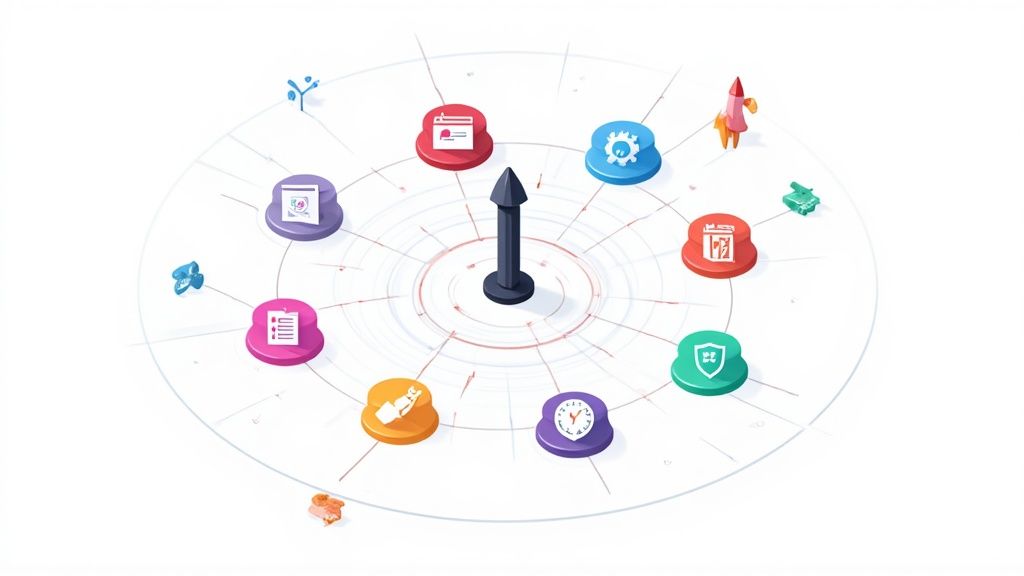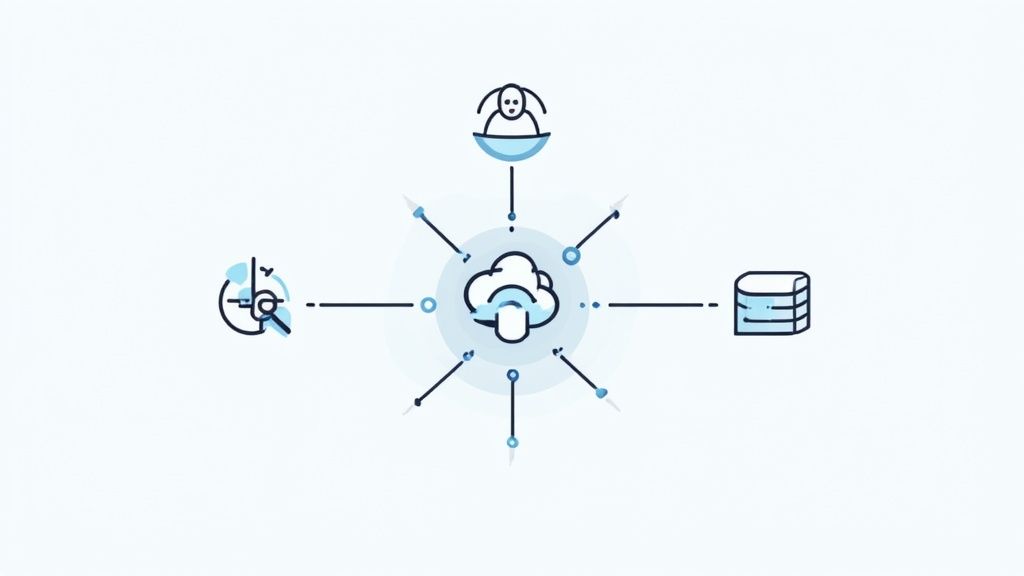10 Key Workflow Automation Benefits to Unlock in 2025

In today's fast-paced environment, 'workflow automation' is more than just a popular term; it’s a fundamental strategy for achieving peak performance. While many associate automation with large corporations and complex software, its core principles can transform personal and professional productivity on any scale. The real power lies in systematically eliminating repetitive, low-value tasks to free up your most valuable resource: your time and cognitive energy. But what tangible results can you expect from this approach? To truly grasp its potential, it's essential to understand the fundamental concept of what workflow automation entails and how it can transform your operations.
This article moves beyond abstract concepts to explore the 10 most impactful workflow automation benefits, providing concrete use cases and actionable steps for each. We will demonstrate how you can achieve these advantages on a personal scale using powerful tools like the Obsibrain template in Obsidian. You'll learn how to turn your digital second brain into a highly efficient, automated command center for your life and work, ensuring you focus on what truly matters. We'll connect each benefit directly to Obsibrain’s features like task management, habit tracking, and the P.A.R.A. system.
1. Increased Operational Efficiency and Productivity
One of the most significant workflow automation benefits is the drastic improvement in operational efficiency. Automation software takes over manual, repetitive tasks, freeing up valuable time and cognitive resources. This allows you and your team to redirect focus from low-impact, administrative work to strategic, high-value activities that drive real progress.
By streamlining processes, automation eliminates bottlenecks and reduces the time required to complete tasks. For example, a McKinsey study found that companies achieved 30-40% productivity gains by automating administrative and data-processing tasks. This isn't just about speed; it's about optimizing resource allocation and increasing overall throughput.
Putting It Into Practice
In Obsibrain, you can automate the creation of your daily agenda. Instead of manually gathering all relevant notes, tasks, and meeting highlights each morning, an automated script in your Daily Note template can pull this information together. For example, it can query tasks tagged with #project-alpha and #due-today, find meeting notes from yesterday linked to the project's central hub, and compile them into a single, structured daily brief.
Key Insight: The goal is not just to do tasks faster, but to eliminate them entirely from your manual workload, creating more space for deep work and creative problem-solving.
This simple automation transforms a time-consuming daily ritual into an instant, reliable process. To learn more about structuring these tasks for maximum impact, explore the details of our advanced task management system. This frees you to start your day analyzing the brief, not building it.
2. Significant Cost Reduction and ROI
Beyond efficiency gains, one of the most compelling workflow automation benefits is a direct and substantial reduction in operational costs. By automating manual processes, you minimize the labor hours required for routine work and significantly decrease the risk of human error, which often leads to expensive rework. This shift allows resources to be reallocated from maintaining systems to innovating within them, delivering a strong return on investment (ROI).

Companies like Telefónica have cut process costs by 30% by embracing automation, while major financial institutions report savings in the hundreds of millions annually. The financial impact is clear: automating the right workflows is a direct investment in your bottom line, with many organizations achieving positive ROI within the first year.
Putting It Into Practice
In Obsibrain, you can automate your freelance financial tracking. Create a template for new client work that automatically adds metadata for rate and status. When you complete a task and mark its status as done, an automated dataview query on your invoice dashboard can instantly calculate the total billable amount for that client, pulling all completed items together. This saves hours of tedious manual calculation.
Key Insight: Automation transforms labor-intensive, recurring costs into a one-time setup investment, creating a compounding financial return over time.
This turns a dreaded monthly task into an automated, error-free report. To see how you can set up powerful organizational structures like P.A.R.A. to support these workflows, check out our guide on structuring your digital brain. This ensures your financial data is not only collected but also organized for strategic review.
3. Enhanced Accuracy and Error Reduction
One of the most critical workflow automation benefits is the significant reduction of human error. Automated systems execute tasks with consistent, machine-level precision, virtually eliminating mistakes common in manual data entry, calculations, and information transfer. This leads to higher-quality work, reduced need for costly rework, and greater data integrity across all your systems.
When processes rely on manual steps, the risk of typos, forgotten details, or miscalculations is always present. Automation enforces consistency, ensuring that every task is performed the same way every time. For example, a study in healthcare found that automated systems could reduce medication prescription errors by as much as 95%, demonstrating the profound impact of removing manual variability. This same principle applies to your personal and professional knowledge management.
Putting It Into Practice
In Obsibrain, you can use templates to enforce accuracy in your knowledge management. For example, when creating a new meeting note, the Obsibrain "Meeting Note" template automatically inserts predefined fields for Attendees, Date, Project, and Action Items. This ensures you never forget to capture critical information and that all your meeting notes are structured identically, preventing inconsistent or missing data.
Key Insight: Automation acts as a quality control system, enforcing rules and consistency to prevent small, manual errors from compounding into significant problems later on.
This simple workflow prevents inconsistent data capture, ensuring your personal knowledge base remains a reliable source of truth. To see how to set up such systems, check out our guide on creating and using dynamic templates. This frees you to focus on the content of the meeting, not the format of the notes.
4. Improved Customer Experience and Satisfaction
Another one of the key workflow automation benefits is the ability to deliver a superior customer experience. Automated systems provide faster response times, consistent service, and personalized communications at scale. This leads to quicker issue resolution and a more seamless journey for your clients, directly boosting satisfaction and fostering loyalty.

Companies like Amazon have perfected this, using automation to process orders and reduce delivery times to a minimum. Similarly, support platforms have found that chatbots can successfully handle a high percentage of routine customer inquiries, freeing up human agents for more complex problems and ensuring customers get immediate help.
Putting It Into Practice
In Obsibrain, you can automate client relationship management. When you conclude a meeting and finalize the notes, an automated trigger can create a follow-up task in your system, scheduled for one week later, with a pre-populated link to the meeting note. The task could be "Follow up with [Client Name] regarding action items from our call." This ensures no client communication falls through the cracks.
Key Insight: Automation enhances the customer experience not by replacing human interaction, but by handling the predictable, administrative tasks, allowing you to focus your energy on building genuine relationships.
This systematic approach transforms client management from a manual checklist into a reliable, automated process. To see how you can integrate these workflows, check out our guide to managing meetings and client relationships. This helps you deliver a high-touch experience without the high-effort workload.
5. Scalability Without Proportional Cost Increases
A crucial workflow automation benefit is the ability to grow without a linear increase in costs. Manual processes require more people to handle more work, but automated systems can process exponentially larger volumes with minimal additional resources. This allows you to scale your operations, whether for a business or a personal project, without the friction of proportional hiring or expanding your time commitment.
Automated workflows handle increased demand seamlessly. Think of e-commerce platforms like Shopify managing massive traffic spikes during Black Friday without crashing. The same principle applies to your personal system; a well-designed automation can handle ten inputs just as easily as it handles ten thousand. This creates an infrastructure built for growth from day one.
Putting It Into Practice
In Obsibrain, the P.A.R.A. method is designed for scalability. You can create an automated workflow for content creation. A new idea note tagged #idea is automatically listed on your "Idea Inbox" dashboard. When you add a #drafting tag, it moves to the "Drafts in Progress" view. This system works identically whether you're managing five content ideas or five hundred, ensuring your organizational overhead doesn't increase as your creative output grows.
Key Insight: True scalability means your systems can handle 100x the workload without requiring 100x the effort. Automation decouples your output from your direct, minute-by-minute involvement.
This approach lets you focus on creating more, not managing more. To ensure your system architecture is ready for this growth, consider our guide on building a scalable P.A.R.A. system. You can scale your ambitions without being buried by the logistics.
6. Enhanced Compliance and Risk Management
Another one of the core workflow automation benefits is its ability to enforce policy adherence and simplify compliance. Automated systems ensure that processes follow a predefined, compliant path every single time, drastically reducing the chance of human error. This creates a reliable, built-in system for risk management and maintains a detailed audit trail for every action taken.
Organizations in regulated industries, like finance or healthcare, leverage this to meet stringent requirements such as GDPR or HIPAA. By automating data handling and approval workflows, companies can demonstrate compliance to auditors with verifiable, timestamped logs. This minimizes legal risks, avoids costly penalties, and builds a foundation of operational integrity.
Putting It Into Practice
In Obsibrain, you can apply this principle to manage client privacy for a freelance business. Create a "New Client" template that automatically generates a checklist note whenever a project is tagged with #client-onboarding. This checklist can include mandatory tasks like "Confirm NDA is signed" and "Verify client data is stored in encrypted folder." The tasks must be checked off before the project status can be moved to "Active."
Key Insight: Automation transforms compliance from a manual checklist you might forget into a non-negotiable, embedded step in your workflow, ensuring consistency and accountability.
This system guarantees that critical compliance steps are never overlooked. To take this further, you can integrate this with our P.A.R.A. organizational structure by learning how to manage your digital information effectively. This ensures that all compliance-related documentation is stored in a consistent and easily auditable manner from day one.
7. Better Data Insights and Decision-Making
Automated workflows are more than just task-doers; they are powerful data generators. Every automated action creates a digital footprint, which, when aggregated, provides a wealth of information. This continuous data collection allows for the creation of real-time analytics and reports that support data-driven strategic decisions.
Instead of relying on gut feelings or outdated information, you can identify trends, pinpoint inefficiencies, and discover opportunities as they happen. One of the key workflow automation benefits is this transformation from reactive problem-solving to proactive optimization. For example, financial services firms use automated systems to detect fraud patterns instantly, a task that would be impossible with manual review alone.
Putting It Into Practice
In Obsibrain, you can automate personal productivity analytics. By consistently using metadata like time-spent on your tasks, a Dataview query in your weekly review note can automatically generate a report. This report can visualize how many hours you dedicated to each project or area of your life, helping you see if your time allocation aligns with your stated priorities, without any manual tracking.
Key Insight: Automation transforms your work from a series of isolated tasks into a measurable system, giving you the clarity needed to make smarter, evidence-based improvements.
This data-centric approach helps you manage your personal workload like a strategic project. To get started with creating these dynamic views, check out our guide on leveraging dataview for personal analytics. This allows you to optimize your efforts based on real performance data, not just assumptions.
8. Improved Employee Satisfaction and Retention
A key workflow automation benefit often overlooked is its profound impact on employee morale and retention. When automation handles monotonous, low-value administrative tasks, it frees employees to engage in more stimulating, strategic, and creative work. This shift not only reduces the risk of burnout but also fosters a greater sense of purpose and job satisfaction.
Companies that embrace this find that it directly correlates with lower turnover rates. For instance, some businesses have reported a 25% reduction in turnover after automating tedious administrative processes. This happens because employees feel their skills are better utilized, leading to improved morale and a stronger commitment to the organization.
Putting It Into Practice
Within Obsibrain, you can automate the tedious parts of your weekly review. Instead of manually searching for what you accomplished, an automated script in your "Weekly Review" template can do the heavy lifting. The script can gather all tasks completed in the last seven days, pull key insights from meeting notes tagged #summary, and compile it all into a pre-formatted document, so you can focus on reflection and planning, not data hunting.
Key Insight: Automation isn't about replacing people; it's about re-engaging them with the work that matters most, creating pathways for growth and increasing their overall value.
This turns a dreaded weekly chore into an efficient, forward-looking planning session. Employees can focus on strategic reflection and goal setting rather than tedious data compilation. To learn more about setting up this kind of system, check out our guide on creating a dynamic P.A.R.A. dashboard.
9. Faster Time-to-Market and Innovation Velocity
Another powerful workflow automation benefit is the acceleration of key business processes, which dramatically reduces the cycle time for everything from product launches to feature releases. Automation collapses the time between idea and execution, allowing teams and organizations to respond to market opportunities and customer demands with unprecedented speed. This agility is a significant competitive advantage in today's fast-paced landscape.
Tech giants like Netflix and Amazon leverage automation to deploy updates thousands of times a day, shifting their development cycle from months to minutes. This isn't just about being faster; it's about creating a system for rapid, continuous improvement. By automating testing, quality assurance, and deployment pipelines, they can iterate on innovation at a velocity that manual processes simply cannot match.
Putting It Into Practice
Within Obsibrain, you can accelerate personal or team projects. Use the Smart Projects system to create an automated "product launch" checklist. When you move a project's status to Final Review, an automation can trigger the creation of this checklist. This list can include standard tasks like "Draft announcement post," "Prepare user documentation," and "Schedule social media updates," ensuring the final, crucial steps are never forgotten and can be initiated instantly.
Key Insight: Automation transforms innovation from a series of slow, discrete steps into a continuous, high-velocity flow, enabling you to test ideas and deliver value more quickly.
This automation ensures no critical steps are missed during a high-pressure launch and standardizes the process for consistency. To discover how to build these dynamic and responsive project frameworks, you can learn more about our Smart Projects system. You end up spending your time refining the feature, not managing the release logistics.
10. Seamless Integration Across Systems and Elimination of Data Silos
One of the most powerful workflow automation benefits is the ability to connect disparate systems and applications, allowing data to flow freely between them. This breaks down information silos, where data is trapped within a single platform like a CRM or project manager. By creating bridges between your tools, automation builds a unified, holistic view of your operations.
This integration ensures that everyone is working with the most current information, which drastically improves cross-functional collaboration and decision-making. For instance, when sales, inventory, and supply chain systems are connected, a retail organization can respond to market changes in real time.

Putting It Into Practice
Obsibrain can serve as a central hub by integrating with external tools through plugins or services like Zapier. For instance, you can set up an automation where any new task created for you in a team's Asana project is automatically added to your Obsibrain daily note. Similarly, an article you save in Pocket can trigger the creation of a new literature note in your "Resources" folder in Obsibrain, complete with source link and tags.
Key Insight: True workflow mastery isn't about finding one perfect tool; it's about creating a frictionless ecosystem where all your specialized tools work together as one.
This eliminates the need to manually copy-paste information, ensuring your knowledge base is always complete and up-to-date without redundant effort. For a deeper dive into making your automation efforts cohesive, explore resources on how AI solutions integrate with existing systems to eliminate data silos.
Top 10 Workflow Automation Benefits Comparison
Increased Operational Efficiency and Productivity
Moderate — workflow mapping and initial setup; ongoing maintenance
Low–Medium — automation tools, some retraining
Faster task completion; 30–40% productivity gains reported
High‑volume repetitive admin tasks, invoice processing
Frees staff for strategic work; reduced overhead
Significant Cost Reduction and ROI
Moderate — integration and licensing upfront
Medium — licensing, implementation, training costs
40–70% cost reduction; ROI typically 6–12 months 📊
Cost‑sensitive processes with measurable transactions
Rapid, scalable cost savings; improved resource utilization
Enhanced Accuracy and Error Reduction
High precision required in configuration; thorough testing needed
Low–Medium — validation rules, monitoring tools
Error reduction 95–99%; consistency 99.9%+ 📊
Data‑entry, reconciliation, quality checks, regulated workflows
Fewer compliance issues; reduced rework; stronger data integrity
Improved Customer Experience and Satisfaction
Moderate — design hybrid flows and escalation paths
Low–Medium — chatbots, self‑service, monitoring
Response time improvement 50–80%; NPS +10–25 points 📊
Customer support, order processing, 24/7 service models
Faster responses; higher retention; lower service costs
Scalability Without Proportional Cost Increases
High — requires robust architecture and monitoring
Medium–High — cloud resources, load balancing
Capacity increase 10–100x without proportional cost; lower cost/tx 📊
Peak traffic events (e‑commerce), high‑volume transaction systems
Scale efficiently; supports growth and seasonal surges
Enhanced Compliance and Risk Management
High — needs regulatory expertise and frequent updates
Medium — audit logging, monitoring, compliance tools
Violation reduction 80–95%; near‑100% audit readiness 📊
Financial, healthcare, data‑privacy regulated environments
Automated policy enforcement; stronger audit trails
Better Data Insights and Decision‑Making
Moderate — logging, BI integrations, analytics setup
Medium — BI tools, analytics expertise, data pipelines
Real‑time dashboards; faster insights for decision making 📊
Operations monitoring, demand planning, fraud detection
Actionable analytics; early problem detection; optimization
Improved Employee Satisfaction and Retention
Low–Medium — change management and reskilling needed
Low–Medium — training, upskilling programs
Turnover reduction 20–35%; satisfaction +25–40% 📊
Roles with high manual workload; teams facing burnout
Higher morale and retention; better talent attraction
Faster Time‑to‑Market and Innovation Velocity
High — CI/CD pipelines and automated testing required
Medium–High — DevOps tooling, test automation
Time‑to‑market reduction 50–70%; deployment frequency 10–100x 📊
Software releases, product launches, rapid iteration cycles
Accelerates releases; competitive advantage; faster feedback
Seamless Integration Across Systems and Elimination of Data Silos
High — complex integrations and data governance
Medium–High — iPaaS, APIs, monitoring, governance
Data consistency +95%; manual transfer reduced 90–100% 📊
Multi‑system enterprises—CRM, ERP, inventory/supply chain
Unified data view; improved cross‑team collaboration
Start Small, Scale Fast: Your First Step Towards an Automated Workflow
We've journeyed through the transformative landscape of workflow automation benefits, from boosting operational efficiency and cutting costs to enhancing accuracy and improving employee well-being. The core lesson is clear: automation isn't an all-or-nothing proposition reserved for large corporations with vast IT budgets. The most profound changes begin with a single, intentional step. The power to reclaim your time, reduce cognitive load, and achieve your goals more effectively is within your grasp, right now.
The journey doesn't start with complex software or coding. It starts by identifying one recurring point of friction in your daily routine. Is it the chaotic process of preparing for weekly meetings? The mental energy spent deciding what to work on next? Or the struggle to connect project tasks with long-term goals? By isolating one specific challenge, you create a manageable starting point for meaningful change.
From Theory to Action: Your First Automation Project
The true value of understanding workflow automation benefits comes from practical application. Instead of feeling overwhelmed by the possibilities, focus on a single, high-impact implementation. This is where a system like Obsibrain, built within your existing Obsidian vault, becomes a powerful catalyst for change.
Consider these immediate, actionable starting points:
Automate Your Daily Plan: Instead of manually building a to-do list each morning, use an Obsibrain template to automatically pull in scheduled tasks, recurring habits, and high-priority project items into a single, consolidated daily note. This simple automation saves you decision-making energy and ensures you start your day with absolute clarity.
Standardize Project Kickoffs: Create a project template using the P.A.R.A. method. When you start a new project, a single click can generate the entire folder structure, a project brief, a task list, and a meeting notes document. This eliminates setup time and ensures consistency across all your work.
Link Actions to Goals: Leverage Obsibrain’s structured system to automatically link individual tasks back to their parent projects and associated goals. This creates a clear, visual connection between your daily efforts and your ultimate objectives, keeping you motivated and on track.
The Cumulative Power of Small Wins
Mastering these small-scale automations builds momentum. Each optimized process frees up mental bandwidth and time, which you can then reinvest into automating the next-highest-friction task. This iterative approach is the key to sustainable growth. You are not just completing tasks more efficiently; you are building an integrated, intelligent system that scales with your ambitions.
The benefits compound over time. A templated meeting note system leads to better data capture. Better data capture informs more strategic decision-making. Strategic decisions accelerate your progress towards key goals. What begins as a simple time-saving trick evolves into a comprehensive framework for personal and professional achievement. The ultimate reward is not just getting more done, but creating the space to focus on the creative, strategic, and deeply human work that truly matters.
Ready to stop managing tasks and start building an intelligent, automated workflow? Discover how the Obsibrain system transforms your Obsidian vault into a powerful productivity engine. Explore the pre-built templates and structured methodologies at Obsibrain and take your first step toward unlocking these workflow automation benefits today.
Last updated
Was this helpful?